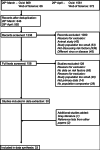Informing the public health response to COVID-19: a systematic review of risk factors for disease, severity, and mortality
- PMID: 33845766
- PMCID: PMC8040367
- DOI: 10.1186/s12879-021-05992-1
Informing the public health response to COVID-19: a systematic review of risk factors for disease, severity, and mortality
Abstract
Background: Severe Acute Respiratory Syndrome coronavirus-2 (SARS-CoV-2) has challenged public health agencies globally. In order to effectively target government responses, it is critical to identify the individuals most at risk of coronavirus disease-19 (COVID-19), developing severe clinical signs, and mortality. We undertook a systematic review of the literature to present the current status of scientific knowledge in these areas and describe the need for unified global approaches, moving forwards, as well as lessons learnt for future pandemics.
Methods: Medline, Embase and Global Health were searched to the end of April 2020, as well as the Web of Science. Search terms were specific to the SARS-CoV-2 virus and COVID-19. Comparative studies of risk factors from any setting, population group and in any language were included. Titles, abstracts and full texts were screened by two reviewers and extracted in duplicate into a standardised form. Data were extracted on risk factors for COVID-19 disease, severe disease, or death and were narratively and descriptively synthesised.
Results: One thousand two hundred and thirty-eight papers were identified post-deduplication. Thirty-three met our inclusion criteria, of which 26 were from China. Six assessed the risk of contracting the disease, 20 the risk of having severe disease and ten the risk of dying. Age, gender and co-morbidities were commonly assessed as risk factors. The weight of evidence showed increasing age to be associated with severe disease and mortality, and general comorbidities with mortality. Only seven studies presented multivariable analyses and power was generally limited. A wide range of definitions were used for disease severity.
Conclusions: The volume of literature generated in the short time since the appearance of SARS-CoV-2 has been considerable. Many studies have sought to document the risk factors for COVID-19 disease, disease severity and mortality; age was the only risk factor based on robust studies and with a consistent body of evidence. Mechanistic studies are required to understand why age is such an important risk factor. At the start of pandemics, large, standardised, studies that use multivariable analyses are urgently needed so that the populations most at risk can be rapidly protected.
Registration: This review was registered on PROSPERO as CRD42020177714 .
Keywords: COVID-19; Coronavirus; Morbidity; Mortality; Review; Risk factors; Systematic review.
Conflict of interest statement
CR is a member of the Scottish Government’s Chief Medical Officer’s COVID-19 Advisory Group, a member of the UK SPI-M committee and the Commission Human Medicines COVID-19 Vaccine Safety Benefits and Risks Working Group. JLKM is Incident Director for COVID-19 at Public Health Scotland and reports no conflicts of interest. LDR serves on a number of Scottish Government Advisory Groups, including COVID-19. MEJW is a member of the SPI-M advisory committee for the UK Government and the Covid-19 Advisory Group for the Scottish Government. AS is a member of the Scottish Government’s Chief Medical Officer’s COVID-19 Advisory Group and the New and Emerging Respiratory Virus Threats (NERVTAG) Risk Stratification Subgroup. HRS is an advisor to the Scottish Parliament’s COVID committee. The views represented in this article do not represent the views of the UK or Scottish Government. All other authors declare that they have no competing interests.
References
-
- World Health Organization. WHO Director-General's opening remarks at the media briefing on COVID-19 2020 [updated 11th March 2020. Available from: https://www.who.int/dg/speeches/detail/who-director-general-s-opening-re.... Accessed 20 Mar 2020.
-
- Ortiz JR, Perut M, Dumolard L, Wijesinghe PR, Jorgensen P, Ropero AM, Danovaro-Holliday MC, Heffelfinger JD, Tevi-Benissan C, Teleb NA, Lambach P, Hombach J. A global review of national influenza immunization policies: analysis of the 2014 WHO/UNICEF joint reporting form on immunization. Vaccine. 2016;34(45):5400–5405. doi: 10.1016/j.vaccine.2016.07.045. - DOI - PMC - PubMed
-
- NHS Digital. Coronavirus (COVID-19): Shielded patients list 2020. Available from: https://digital.nhs.uk/coronavirus/shielded-patient-list. Accessed 27 May 2020.
Publication types
MeSH terms
Grants and funding
LinkOut - more resources
Full Text Sources
Other Literature Sources
Medical
Miscellaneous


